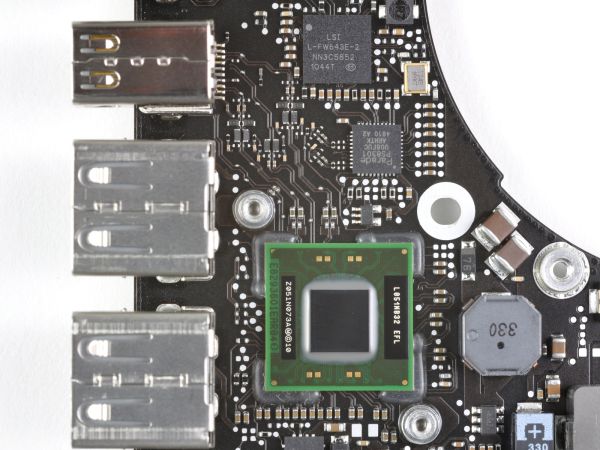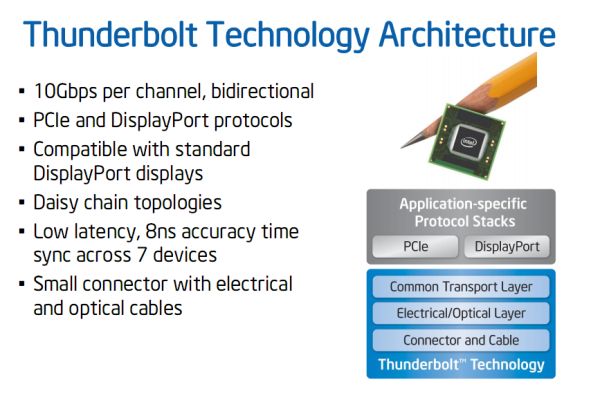Intel's Codename Light Peak Launches as Thunderbolt
by Brian Klug on February 25, 2011 1:10 AM EST- Posted in
- CPUs
- LightPeak
- News
- Thunderbolt
Back at IDF 2010, we wrote about Intel Light Peak nearing its eventual launch in 2011. Back then, the story was a 10 Gbps or faster physical link tunneling virtually every protocol under the sun over optical fiber. Though an optical physical layer provided the speed, in reality the connector and physical layer itself wasn’t as important as the tunneling and signaling going on beneath it. The dream was to provide a unified interface with enough bandwidth to satisfy virtually everything desktop users need at the same time - DVI, HDMI, DisplayPort, USB, FireWire, SATA, you name it. Daisy chain devices together, and connect everything with one unified connector and port. At IDF, we saw it moving data around between an Avid HD I/O box, a Western Digital external RAID array, and simultaneously outputting audio and video over HDMI. Intel also had another live demo working at over 6.5 Gbps.
That dream lives on today, but sans optical fiber and under a different name. Intel’s codename “Light Peak” is now named Thunderbolt. In addition, instead of optical fiber, ordinary copper does an adequate enough job until suitably cheap optical components are available. It’s a bit tough to swallow that optical fiber for the desktop still isn’t quite ready for mainstream consumption - issues like bend radius and the proper connectors were already mitigated - but copper is good enough in the meantime. Thunderbolt launched with the 2011 MacBook Pro, and though the interface isn’t Apple exclusive, will likely not see adoption in the PC space until 2012.
Although Thunderbolt in its launch instantiation is electrical, future versions will move to and support optical connections. When the transition to optical takes place, legacy electrical connector devices will work through cables with an electro-optical transceiver on the cable ends so there won’t be any need to use two separate kinds of cables. The optical version of Thunderbolt is allegedly coming later this year.
Thunderbolt shares the same connectors and cabling with mini DisplayPort, however Thunderbolt cables have different, tighter design requirements to fully support Thunderbolt signaling. DisplayPort is an interesting choice since it’s already one of the fastest (if not the fastest) desktop interfaces, topping out at 17.28 Gbps in DisplayPort 1.2 at lengths of under 3 meters. At longer distances, physics rears its ugly head, and throughput drops off over electrical links. Of course, the eventual advantages of moving to photons instead of electrons are greater distance without picking up much latency.
Thunderbolt is dual-channel, with each channel supporting 10 Gbps of bidirectional bandwidth. That’s a potential 20 Gbps of upstream and 20 Gbps of downstream bandwidth. The connection supports a daisy chain topology, and Thunderbolt also supports power over the cable, 10W to be precise. We aren't sure at this time what the breakdown on voltage/amperage is though.
Back when it was Light Peak, the goal was to tunnel every protocol under the sun over a common fast link. Multiplex everything together over one protocol-agnostic link, and then you could drop relevant data for each peripheral at each device in the daisy chain. Up to 2 high-resolution DisplayPort 1.1a displays and 7 total devices can be daisy chained. Thunderbolt instead carries just two protocols - DisplayPort and PCI Express. Tunnel a PCIe lane over the link, and you can dump it out on a peripheral and use a local SATA, FireWire, USB, or Gigabit ethernet controller to do the heavy lifting. Essentially any PCI Express controller can be combined with the Thunderbolt controller to act like an adapter. If you want video from the GPU, a separate dedicated DisplayPort link will work as well. Looking at the topology, a 4x PCI Express link is required in addition to a direct DisplayPort connection from the GPU.
Apple learned its lesson after FireWire licensing slowed adoption - the Thunderbolt port and controller specification are entirely Intel’s. Similarly, there’s no per-port licensing fee or royalty for peripheral manufacturers to use the port or the Thunderbolt controller. iFixit beat Anand and me to tearing down the 2011 MacBook Pro (though I did have one open, and was hastily cramming my OptiBay+SSD and HDD combo inside) and already got a shot of Intel's Thunderbolt controller, which itself is large enough to be unmistakable:
 Thunderbolt Controller IC on 15" 2011 MacBook Pro - Courtesy iFixit
Thunderbolt Controller IC on 15" 2011 MacBook Pro - Courtesy iFixit
In addition, you can still plug normal mini Display Port devices into Thunderbolt ports and just drive video if you so choose.
Though there aren’t any Thunderbolt compatible peripherals on the market right now, Western Digital, LaCie, and Promise have announced storage solutions with Thunderbolt support. Further, a number of media creation vendors have announced or already demonstrated support, like the Avid HD I/O box we saw at IDF.
Thunderbolt already faces competition from 4.8 Gbps USB 3.0 which has already seen a lot of adoption on the PC side. The parallels between USB 2.0 / FireWire and USB 3.0 / Thunderbolt are difficult to ignore, and ultimately peripheral availability and noticeable speed differences will sell one over the other in the long run. Moving forwards, it’ll be interesting to see Thunderbolt finally realize the “light” part of Light Peak’s codename, and exactly how that transition works out for the fledgling interface.















106 Comments
View All Comments
bupkus - Friday, February 25, 2011 - link
GEEK FIGHT!!!mckirkus - Friday, February 25, 2011 - link
"2) Performance will be impacted. PCIe x2 is 8GB/sec, so a single Thunderbolt channel is only a bit more. "Arrgh. 1 Gigabyte(GB) = 8 Gigabits (Gb)
You're confusing people because Thunderbolt is only 10Gb/s, not 10GB/s.
A PCI Express 2.0 x16 Link is 64Gb/s, that's the slot commonly used for video cards and is over six times faster than Thunderbolt in it's current incarnation.
When Thunderbolt is optical and supports 100Gb/s then we can start to look at external video cards.
DanNeely - Friday, February 25, 2011 - link
That's just a capitalization issue, he didn't use the wrong units in his calculation. Sheesh.An 8Gb/sec data link can fit comfortably in a 10Gb/sec channel.
Ryan Smith - Friday, February 25, 2011 - link
"When Thunderbolt is optical and supports 100Gb/s then we can start to look at external video cards."That's probably the key point. The issue at the moment is when 100Gb/sec Thunderbolt will arrive. PCIe 3.0 arrives within a year, and it will push PCIe x16 to 128Gb/sec, at which point Thunderbolt would again be slower, although not by nearly as much as before.
And yes, I screwed up the units, thanks for catching that. This is what happens when you write a comment at 1 in the morning.
Bluestealth - Saturday, February 26, 2011 - link
Why does carrier frequency have anything to do with signal propagation velocity? Wait it doesn't. I would suspect that the protocol overhead is far greater factor than the velocity of light in a conductor, which at these length scales is going to be less than 20 ns. Hardly a delay worth mentioning.Rick83 - Sunday, February 27, 2011 - link
It's still on the level of several GPU/CPU cycles - so if you need to actually interactively communicate between the two, both sides will lose massive amounts of their potential performance.Of course, if you need massive intercommunication for your computation you're lost in any case, it's only that lately the physical limitations are becoming evident where previously there were merely implementation problems (we could probably link up a huge amount of 386's today without any loss of performance - the same was not possible in their era)
So if you're only streaming, signal propagation isn't a problem. It's only in latency bound scenarios where insanely high speed individual components will not be able to run at their full potential. Along this self same axis, we are probably already at )or quickly approahing) the hard RAM-latency wall, until we move that too onto the CPU...
softdrinkviking - Friday, February 25, 2011 - link
No, I think it was originally supposed to support everything, but they cut it back probably for cost reasons. I'm sure interpreting more protocols increases the complexity of the controller, ect.Also, the change to copper may have had an influence on that decision.
Or maybe it's an intel/apple conspiracy to eliminate USB.
nafhan - Friday, February 25, 2011 - link
It sounds like something along the lines of a PCIe USB controller + Thunderbolt controller would work. Where this will really come in handy is having things like a USB3 controller built into a computer monitor. That would eliminate at least one cable from the monitor the PC.pugster - Friday, February 25, 2011 - link
Thunderbolt technology is like Firewire on Steroids with the same problems plaguing it. Too complicated and need to connect to display adapter. Not to mention royalty fees. USB is a cheaper, simpler technology and it works.Spazweasel - Friday, February 25, 2011 - link
"Thunderbolt technology is like Firewire on Steroids with the same problems plaguing it. ... Not to mention royalty fees. USB is a cheaper, simpler technology and it works"Wrong.
Directly from the article: "Similarly, there’s no per-port licensing fee or royalty for peripheral manufacturers to use the port or the Thunderbolt controller."